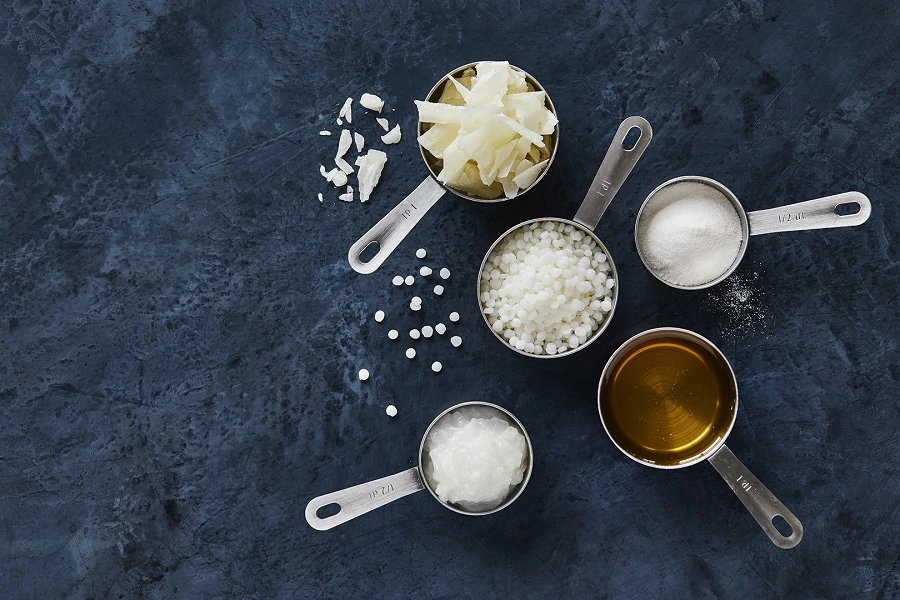
- Industry news
Industry news
- Category news
Category news
- Reports
- Key trends
- Multimedia
- Journal
- Events
- Suppliers
- Home
- Industry news
Industry news
- Category news
Category news
- Reports
- Key trends
- Multimedia
- Events
- Suppliers
Emulsifier evolution: Formulators target plant-based, clean label & alt-dairy innovation
Key takeaways
- Emulsifier manufacturers explore plant-based and co-emulsifiers to meet consumer demands for “clean and leaner” labels.
- Sustainable sourcing practices, including RSPO-certified palm oil and plant-based proteins, are gaining ground in efforts to reduce environmental impact.
- Innovations target dairy substitutes to enhance texture, creaminess, and stability in plant-based milks and yogurts, resulting in improved mouthfeel.
 Sternchemie’s technologists working on new solutions in its lecithin and lipid laboratory (Image credit: Sternchemie).
Sternchemie’s technologists working on new solutions in its lecithin and lipid laboratory (Image credit: Sternchemie).The growing consumer scrutiny of ingredient labels and push for transparency are driving manufacturers to replace or enhance traditional emulsifiers. From lecithin alternatives to exploring hybrid blends, key players in the sector are expanding emulsifiers’ versatility while ensuring their applications in confectionery, bakery, and dairy alternatives meet the evolving expectations of today’s conscious consumer.
Companies are developing emulsifiers to not only improve product quality but also to reduce the need for additional additives. Sustainable sourcing practices are also advancing to address environmental concerns associated with ingredients like palm oil, which is used in margarine and spreads to enhance texture and prevent ingredient separation.
Innova Market Insights’ Lifestyle & Attitudes Survey 2025 highlights consumers’ growing focus on transparency, revealing that 48% of consumers globally say they “always or often” seek information on food quality before purchasing products.

Food Ingredients First discusses the evolution of emulsifier innovations with experts at Sternchemie and Palsgaard to explore how the sector is adapting to meet evolving consumer expectations as regulations tighten and the focus on sustainability intensifies.
Dr. Roland Rabeler, head of business development at Sternchemie, says plant-based solutions play a key role in the development of clean label emulsifiers.
“Especially in light of the debate surrounding the adverse effects of synthetic and chemically modified emulsifiers, customers expect safe and healthy solutions they know and trust,” says Rabeler.
“This development is about complementing and expanding the existing functionality and applicability of natural emulsifiers. Sternchemie achieves this through targeted treatment and fractionation of lecithin or combinations with synergistically effective co-emulsifiers.”
He also points to the growing consumer preference for plant-based proteins, as protein-based emulsifiers used to create stable emulsions in food are often derived from animal products, such as eggs or milk. “In addition to fluctuations in raw material prices and availability, there is a growing consumer preference for plant-based proteins driving the search for alternative solutions.”
Enhancing alt-dairy
Rabeler explains that combining plant proteins with lecithin creates “powerful functional synergies” that can enhance emulsification, stability, mouthfeel, and texture in dairy substitutes.
 Customers demand safe and trusted solutions amid concerns over the adverse effect of synthetic emulsifiers, says Rabeler at Sternchemie.“A series of interactions between the proteins and the components in the lecithin at the oil-water interface ultimately lead to a change in surface tension.”
Customers demand safe and trusted solutions amid concerns over the adverse effect of synthetic emulsifiers, says Rabeler at Sternchemie.“A series of interactions between the proteins and the components in the lecithin at the oil-water interface ultimately lead to a change in surface tension.”
“It is this type of synergy that makes plant-based milk creamier and adds shelf stability, which gives plant-based mayonnaise an improved texture and spreadability, or nutritional shakes better nutrient protection and bioavailability,” he explains.
Nicolai Arent, regional application manager EMEA at Denmark-based Palsgaard, also highlights the possibility of creating milk alternatives with a “similar mouthfeel and texture to traditional dairy.” However, he notes that the types of fat they contain indicate the sensitivity of the emulsion, leading to issues with sedimentation, flocculation, and fat separation.
“Emulsifiers improve milk alternatives by preventing fat separation and help improve the overall creaminess of the product. Stabilizers are also important to prevent serum separation and sedimentation, helping to improve the overall mouthfeel and the product’s stability.”
“Palsgaard also has a special emulsifier-stabilizer blend called Palsgaard MilkFoam 204 that can be used to create frothy plant milks. It minimizes the amount of foam created during production while providing a very fine, micro-foam layer on top of the coffee.”
For yogurts, Arent observes consumer demands for textures that are “smooth and glossy with a clean mouthfeel” in most countries.
“Palsgaard AcidMilk 310 is our stabilizer blend for plant-based yogurts and helps to deliver good texture and creamy mouthfeel, as well as increasing shelf life and stability during storage and distribution. Perhaps the biggest benefit, though, is that it reduces water separation, which is a huge issue for plant yogurts.”
Cleaner and leaner labels
Arent says that “cleaner and leaner” labels are becoming more important, but manufacturers ultimately rely on emulsifiers to deliver performance and cost reductions.
 Palsgaard’s lecithin alternatives allow improved production efficiency, stability, and spatter control in margarine (Image credit: Palsgaard).“We offer a range of solutions that can help brands simplify labels without having to compromise on quality or sacrifice the cost savings,” he says.
Palsgaard’s lecithin alternatives allow improved production efficiency, stability, and spatter control in margarine (Image credit: Palsgaard).“We offer a range of solutions that can help brands simplify labels without having to compromise on quality or sacrifice the cost savings,” he says.
“For example, in industrial cakes, if you use our Palsgaard SA 6610 emulsifier instead of cake gels, you can go from five or six E-numbers to just one. For a plant-based yogurt, our Palsgaard AcidMilk 310 is a stabilizer system that is composed of starch and vegetable fiber and doesn’t require any E-numbers at all.”
Palsgaard recently expanded its production of plant-based emulsifiers for bakery premixes to Brazil. Its Emulpals range enables healthier cake formulations by replacing saturated or trans fats with unsaturated oils.
Replacing lecithin
Scientists consider lecithin the “oldest and most known” emulsifier in chocolate, but its off-taste, allergenicity, and genetic modification concerns drive the need for alternatives. In the 1960s, Ammonium Phosphatides (AMP) was developed as a substitute, eliminating off-tastes and odors.
Palsgaard’s sunflower-based Palsgaard AMP 4455 and rapeseed-based Palsgaard AMP 4458 are the latest developments in AMP chocolate emulsifiers. These ingredients allow for “substantial reductions” in cocoa butter use compared to lecithin.
“Given that cocoa butter is usually the most expensive ingredient in chocolate production, that means huge improvements in cost-in-use. They also come in a liquid and easy-flowing form, making them easy to dose at any temperature and add directly to the production,” says Arent.
 AMP has various advantages over lecithin such as the absence of off-tastes and odors, says Arent at Palsgaard.Lecithin is used in margarine to blend water and oil, improving texture and inhibiting bacterial growth. However, its functionality is limited, requiring high volumes, which can cause stickiness at high temperatures and affect appearance.
AMP has various advantages over lecithin such as the absence of off-tastes and odors, says Arent at Palsgaard.Lecithin is used in margarine to blend water and oil, improving texture and inhibiting bacterial growth. However, its functionality is limited, requiring high volumes, which can cause stickiness at high temperatures and affect appearance.
“To address those issues, we’ve created Palsgaard 0170, which is based on Roundtable on Sustainable Palm Oil (RSPO) SG-certified palm oil, and Palsgaard 0172, which is based on rapeseed. They are lecithin alternatives that allow for increased production efficiency, improved product stability, and enhanced spatter control,” Arent shares.
Meanwhile, Sternchemie’s focus is on “extending lecithin functionality,” Rabeler tells us.
“This way, we deliver technical performance without compromising on label simplicity. We aim to replace artificial emulsifiers without major changes in formulation or processing, so it is easy to use and affordable for customers while meeting consumers’ needs for trusted and safe ingredients.”
Sustainable sourcing
As the F&B industry continues to prioritize environmental sustainability, emulsifier manufacturers are exploring more sustainable sourcing and production methods.
The lecithin industry uses a by-product or waste stream from the oil milling industry as a starting point for its adaptations to functional, quality, and process requirements, says Rabelers.
 Sternchemie leverages botanical alternatives to soy, such as sunflower to produce lecithin (Image credit: Sternchemie).Sternchemie exclusively uses blending, physical, and mild enzymatic processes to standardize our products and adapt them to its customers’ requirements. “By focusing on botanical alternatives to soy and sourcing regionally wherever possible, we not only ensure the security of supply and quality of our products but also reduce our environmental impact in the long term,” adds Rabelers.
Sternchemie leverages botanical alternatives to soy, such as sunflower to produce lecithin (Image credit: Sternchemie).Sternchemie exclusively uses blending, physical, and mild enzymatic processes to standardize our products and adapt them to its customers’ requirements. “By focusing on botanical alternatives to soy and sourcing regionally wherever possible, we not only ensure the security of supply and quality of our products but also reduce our environmental impact in the long term,” adds Rabelers.
For Palsgaard, responsible sourcing, efficient formulation, and reduced waste are key focuses for offering environmental and commercial value, says Arent.
“We’ve introduced a number of measures to reduce CO2e emissions and energy consumption as part of our ESG commitments, including building a 52-hectare solar plant in Denmark.” The company sources 100% RSPO-certified segregated palm oil and develops non-palm alternatives to manufacturers’ sustainability needs.
“Another benefit of our emulsifiers is that they help our customers minimize food loss, waste, and scarcity by improving raw material efficiency. Our AMP emulsifiers allow manufacturers to use less cocoa butter at a time when global cocoa supplies are under pressure.”
A fermented future?
Rabeler expects significant technological developments and advances, especially in fermented emulsifiers, to inspire industry innovation.
“At the same time, I expect increasing cost pressure and regulatory hurdles, as well as consumers who continue to value the safety and familiarity of the ingredients. All in all, I expect that the tried-and-tested lecithin and lecithin-based systems will continue to play a key role,” he says.
He also anticipates advancements in blended solutions depending on the application and requirements, including 1:1 substitutes or hybrid solutions, such as the combination of lecithin, plant-based proteins, and hydrocolloids.










